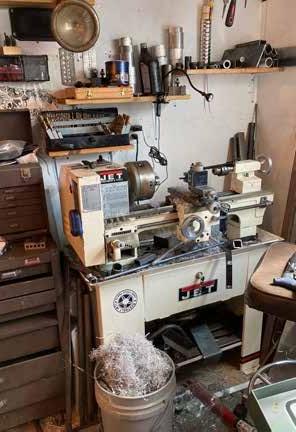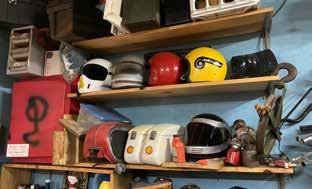
8 minute read
My Garage - Tyson Fritts
TYSON FRITTS'
My workspace in Indianapolis started INDY GARAGE and found a white CA95 “Benly” Dream out in a area that is now full of vintage in unrestored but complete condition, Hondas; from a CB550 with a sidecar full of the usual mice nests and funk for in-town trips with the family, to associated with band finds, and an older “Frankenstein” bikes built for motorcycle shows, Yamaha V-Max along with an assortment of to other vintage Hondas ranging from those in tools. I let my friend take the Yamaha. After restored condition to “patina perfect” period mod dragging the Benly back to my garage, I started bikes. Except for the three-foot mini ramps, complete with cleaning it out, researching parts. I will never forget getting spine and four-foot extensions on the side, as long as the garage it to fire for the first time and riding it down the alley, carb door stayed down, it didn’t stand out at all. It’s just a plain old leaking all over the place, while holding up my makeshift plastic two-car garage in the middle of the city next to a cultural trail bottle gas tank. Once that one was road worthy, I bought a for biking and walking. I had a new Honda Shadow I bought CB350F and it was all downhill from there. I quickly realized on payments right after I signed my first teaching contract, but that as long as I had a bike that started and ran trouble-free, nothing “vintage” at all. working on other bikes wasn’t stressful at all. In fact, it was,
At that time, I was more focused on riding as much as most of the time, actually more like a stress-relieving puzzle. possible. I took many longer trips to the east coast, Canada, or A puzzle that, after hours and hours of work and a little bit of the gulf with friends. When the weather was nice, I’d open the money, you could ride. An interesting sidenote about the CA95 back and paint little pieces of the chrome black and change 150 Honda Dreams is that the word the oil, but that was the extent to which I “worked “Benly” is actually the Japanese on” bikes. I recall my friends working on their for べんり(便利), which old Hondas and I always thought to myself, means convenient. “That doesn’t look fun, I just want to ride!”
That all changed when my neighbor a few doors down had his house foreclosed on. I just happened to be in my garage when he was driving The fleet through our alley and out of the neighborhood for the last time. He rolled down his window and yelled,”I’ve got some old bikes and tools in my garage that I don’t want, you can have them, just do it soon before the bank sends someone out.” My friend and I giddily ran down to check it out


This may have been part of what got me hooked. As I am a Japanese teacher and translator, the extra detail that the ‘60s Hondas tend to have make them my favorites to work with. I later found out that my mother and her siblings had a couple of these toads and rode them as teenagers. As my garage began to fill with Japanese motorcycles and I started to get better at working on them, the number of bikes in my garage began to grow. In the beginning, I would just get them running well enough to ride around the block a few times and then send them on their way with a few extra dollars in my pocket. After a few years, most of my skateboarder friends had some sort of “custom” bike to ride around town, so there was always someone to ride with. At a certain point, people started buying newer sportsters, then making “choppers” and the number of people to ride with, or maybe it was the number of people I was willing to ride with, started to diminish. I turned my focus toward learning how to rebuild motors. Around that time, I bought a lathe. Being able to make parts, even poorly, from time to time on my own really got me excited to not just make mechanical “upgrades” to my bikes, but also enhance the performance of their motors.
As I was out in the garage more, I started to get increased attention from people riding on the trail behind my garage, which was tiring to say the least. It seemed like every other person would ask if one of my Hondas was a BSA or a Triumph because of a cafe racer show that was popular at the time. I decided to pour concrete and build a lean-to on the side of the garage



where the ramp had been. After getting a local guy on board who agreed to let me do the work with him, phase one of my workshop was complete. I worked out of it for a couple years, taking on projects for other people and working on others’ bikes for fun, usually for no compensation, just to get them back on the road so we could all ride.
The natural progression of working on motorcycles for me around this time was to start looking for a way for me to push them to their limits. With a kid on the way, I didn’t feel like jumping train track bumps and locking my back brakes up to see how far I could slide was a great idea anymore. I had a few friends start racing dirt track, but after a couple times on the track, I realized it wasn’t for me. When I realized I could race smaller Hondas on a road course, it was all I could think about. I got my feet wet by building a CB160 for riding around town. It took me a while to build the motor correctly, but then after I finally figured it out and started to collect parts for my AHRMA bike, life happened.
Within a six-month period, I was diagnosed with a rare form of leukemia, my son was born, and my father passed. For the next four years, I didn’t make it out to the garage as much as I would have liked to as I battled cancer. My spleen was the size of a football and I couldn’t ride much anyway so I sold a few bikes to pay medical bills and explore experimental treatments. My dream of racing with AHRMA had to be put on hold. I did build one bike during this time, often with my son strapped

Retired cruiser board
Papa Roro and baby Atlas Along for the ride


Stash


Sloper horde


Helmet hunting Future road racer
to my back as I worked. It was a dilapidated CB77 chopper I picked up at an auction that I converted to a raked and stretched 358cc big bore, dedicated to my father.
In the summer of 2017, after multiple rounds of chemo and a two-week hospital stay, my blood levels finally rebounded, and I was officially considered in remission. That spring, I scrapped almost two tons of motorcycle parts, many of which I still regret, and started phase two of the shop. I removed the inside wall of the garage and made a platform extending three feet into the garage for in-shop storage and workspace and installed an A/C unit. That winter, I started to make plans to assemble a Honda CL175 sloper, the bike I was able to ride when racing with AHRMA this past season.
I am currently building a few different bikes and am back on the fix and flip game. After becoming a father though, my time is much more valuable, so nothing is done for free anymore. Since before he could walk, my son, Atlas, has been in the shop with me when I work. He is happy building things with extra and scrap parts that I keep for him. It’s amazing what he can come up with using random parts. At six years old, Atlas is now working on his first official project: a QA50. He obviously needs a lot of guidance, but he has put in a lot of work.
As for the CL175, it will be back up on the lift soon for various upgrades and I also have about five bikes to fix up for sale in the spring.
My shop/garage/remote storage unit I work with now is enough for my current needs but I hope that in the not too distant future I can get myself into a position where I can build or have a nice sized pole barn with more room to work. My space is cramped and full of trinkets from swap meets. With my son working alongside me, I’m sure it won’t be long until he needs his own, larger space.
We are both looking forward to a more “normal” racing reason. For now, taking our dirt bikes out to our family and friends’ property will have to be enough.










